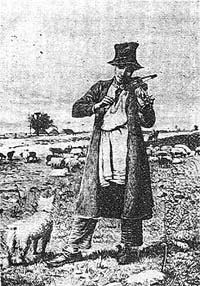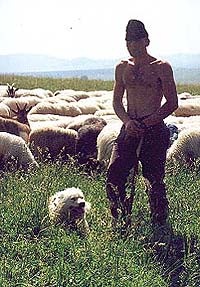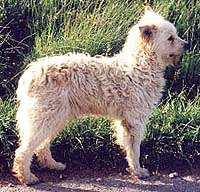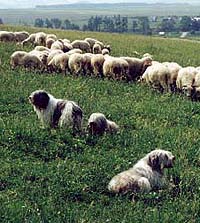|

fragment of woodcut...

St.Maslowski - woodcut 1882 r.

pasturage of sheeps ...

... from Borys...

... our bitches
|
Danuta Forelle ( "Pies" Magazine 1965)
Herding dogs
inhabited Polish territory since ancient times. Evidence of this is
present in archeological discoveries, written and iconographical sources.
With the begining of Polish literature treatices regarding hunting and
herding dogs already appear. Piotr Crescentyn in 1549 wrote that short
note ought to be devoted to dogs protecting cattle from wolves.
The type
of structure and temperament of the herding dog developedaccording to
the requirements of the various farms. Lowland sheepdog was kept in
sheep-folds as a necessary helper for shephards. In deeds of Zamyski's
estate, where sheep farming on a large scale existed since XVI
century,first note about herding dogs comes from 1775. From this note we
learn that in Stroza village, 7 dogs guarded flock of 934 sheep and in
Wilkolazy village 3 dogs helped with 335 sheep.
Between 1830-1843, in
the times of the estates greatest flourishment of the sheep farming,
herding dogs had to be specially selected due to exceptionally delicate
and shy pure-bred sheep. Estates supported sheep farming of the whole
Lublin region, no doubt propagating also local type of herding dog.
Jozef Gerald-Wyzycki in his manual (Science of domestic animal
breeding-Warsaw 1938) writes about sheep dogs, that they are medium size,
their head is narrow and their ears are pricked. They have a long soft
co of different colors, most commonly black, blacked and speckled and
less likely white or brown. Author of "Breading and Veterinary
Guide for farmers" -Warsaw 1839 describes the sheep dogs as a
medium size, good mannered and helpers for shephards. The author warnes
that the dogs should only be white otherwise they could frighten the
sheep and bring about procreation of speckled lambs. There are no
illustration accompanying the above descriptions.
In " Weekly Illustrated" Magazine from 1882 I have found
reproduction of a wood carving depicting a shephard boy with a small
dog, looking like a described above sheepdogs. The view of the dog
displays its distinctive mark, short tail. The short tail undoubtedly is
a natural phenomenon because it is very unlikely that in the past
farmers would dock tails of their dogs. Illustartor then fulfilling a
task of todays photographer, produced pictures for magazines usually
representing natural objects people and animals. It is reasonable to
assume that the dog in wood carving executed by Stanislaw Maslowski is a
faithfull portrait of an early sheepdog.
In the early 20th century the downfall of sheep farms began in
Lublin region. With the decline of farms the shaggy type of sheepdog
disappeared as well. In 1924 magazine " Polish
Poultry"-official magazine of newly formed Polish kennel Club
printed an article urging breeders to work on Polish sheepdogs. Author
Ludwik from Kleczany (priest Ludwik Kleczynski) wrote that he received
as a gift an original sheepdog with the distict spitz features. Dog
named Burus had a very thick, coffee color coat. Burus, as priest
pointed out was born without the natural "ornament", that is
without a tail. With the downy fur the dog looked like a ball of yarn.
In the same year Ludwik from Kleczany (Magazine"Polish Poultry")
in his report from dog show in Warsaw states that breeders
Czertwertynska and Grocholska exhibited polish sheepdogs purchased from
farmers in Siedlce area. Ms. M. Grocholska's female dog received silver
medal. Couple of presented by Grocholska dogs were born bobtailed
and passed this trait to their offsprings.
In magazine "My Dog"- 1937, letter from a breeder of lowland
sheepdogs was published stating that " In Podlasie( Lublin region)
countess Maria Grocholska was the first to notice herding type of dogs
on old farmlands. She purchased a few typical representatives and
commenced selective breeding. This breed proved to be very strong
because in spite of long standing neglect at the hands of peasants the
breed's type remained uniformed. The puppies in our kennel's 12 year
history were always consistend in type and color. Typically the height
at the shoulders was 30-40 centimeters. Presently with the advances of
dog nourishment and after 12 years of selective breeding height
approaches 60 cm. The coat is usually white with biscuit markings on the
back and ears. In our kennel sheepdogs display various abilities. They
are used for herding sheep and cattle as well as guarding. They are also
very pleasant house pets. One of our dogs turned out to be an excellant
wild boar hunter. They are characteristically faithful, intelligent,
brave and vigilant. They also have an excellent sense of smell."
Sheep farming in the area of Siedlce was managed between 1808 and 1909
by gentry and peasants. With the early 20th century sheep
farming began its decline (ource: "Studia do Dziejow Gospodarsta
Wiejskiego", 1956) Around the same time the sheep dog disappeared
as well and as Zoltowska states: single typical representatives of the
breed could only be found in the hands of old shephards.
----------------------------------------------------
During our spring mountain trip this year we have found a
familliar sight...
Near Nowy Targ on the pasture the flock of sheep was grazing under the
supervision of shephard and his helper - a dog. I could not restrain
myself from taking pictures. For 200 years nothing has changed, it seems
on Polish countryside. In the cities life goes on but in some secluded
corners time has come to a halt. Striking similarity of the situation as
well as the dog itself to the wood carving executed by Stanislaw
Maslowski was hard to miss.Of course we spend some time with the
shephard talking and taking pictures. As it turned out Borys (dogs name)
was born without a tail. Generations of similar sheepdogs are bred on
Podhale.The selection process is aimed toward their utility.
Highlanders often exchange the dogs with Slovacks or buy from them
promising puppies.The dogs often look like the one on the included
picture.Borys reminds PON in size and proportions. His coat is coarse,
goaty, long, significantly worn- out on his legs and shorter on the
muzzle.Borys`s ears are pricked.From the first moment it was obvious
that the dog was not there to protect the flock but to keep sheep in
order. When we approached with our three PON girls Borys did not let out
even one bark but sniffed us over with curiosity. This
accomplished, he stepped to the side and observed us from the
distance. We were engrossed in a discussion about dogs with the shephard.
The shephard was quite amused when he learned that our tenderly
caressed furballs are also sheepdogs. He became less sceptical when we
told him that this Polish breed used to herd sheep until very recently.
We were very proud of our PON girls because they completely ignored
sizable flock,as long as sheep moved out of their way.We could
peacefully set to taking pictures of dogs and sheep. The first film was
very quickly
finished and my husband went to the car to pick up another one.
Norma and Wiki followed him. Panda remained with me
by the flock. At some point she changed her mind and decided to follow
my husband as well. With her nose to the ground Panda did not realize
that she was walking into a flock of sheep. Finally 2-3 meters to the
nearest sheep she lifted her head. The sheep were very much interested
in the lonely dog. Panda and the sheep sniffed each other carefully
almost touching noses.Finally one of the
ewes, out of tension, stamped her feet (obviously the intruder smelled
suspiciously). Surprised Panda jumped off and growled. This irritated
the sheep even more and she stamped again...
But Panda did not have time to react . Borys suddenly materialized and
quickly restored the order, saving his quest from the oppression. I was
enchanted by Borys and his reaction. The dog demonstrated an
exceptional intelligence and initiative. His owner was standing by ,observing
and waiting for developments but not reacting. I`m confident ,that the
shephard had a very good idea how his dog would respond. The shephard
summarized the episode stating that Panda would make a good sheepdog.
From this moment the herdsmen started to treat Panda with
affection (if pat on the head counts as such...)
This man was not an emotional type but we managed to gain his liking by
admiring Borys. The shephard was obviously very proud of his dog.
Neighboring shephards were also full of respect and admiration for
Borys. Their Polish Tatra dog were guarding sheep at night. At the end
of our visit (our cameras already packed) we has an opportunity to
witness Borys at work with the flock of sheep. Until now we could
see this only in the movies or on herding trials of border collies. This
visit certainly will stay in my memory. It also inspired some
suggestions regarding directions PON breeding should take. Most
contemporary specimens of this breed are not fit to work as sheep dogs,
at the very least, because of coat that is too long and too soft. Sheep
herding dogs in the past as well as presently charcteristically have
coarse type of coat that does not mat easily. Coat should be softer than
GSD's but it should not be to wooly prone to matting. Doubtfully the
dogs were groomed in the past. Todays PONs are covered by abundant long,
soft coat that requires multitiude of grooming measures. It is true that
coat like this looks impressive on the show ring but for the owner and
the dog it is a great burden.
Often times dogs end up trimmed. Wouldn't it be better to breed dog with
shorter, coarser and easier to manage fur?. In the show ring dogs like
this are underestimated and often ommited but what a comfort it is for
the owners!
There is not many dogs like that around...I 'd like to discuss here one
more problem pertaining dogs intelligence. Preoccupation of breeders
with an exterior diverted attention away from this important trait. At
times also temperament is taken under consideration but intelligence is
completely ignored. This feature was in the past the most important
during development of the breed. Only selected, very intelligent dogs
were able to perform the required tasks. And too bad...It is much more
rewarding to have as a friend an intelligent dog able to understand and
communicate with you. In our household three PON girls reside with us.
Panda is by far more intelligent than the other two. She is a very
stubborn doggy and at times arbitrary but uncannly communicative.
According to our long standing observation, she would be able to perform
many various duties. She understands our intentions in a flash. She
performs requested task
eagerly, because she hates to be bored. Although as a very respectable
PON she does everything in her own way. At times we have a chance to
observe a performance of a few border collies, universally known as the
most intelligent breed. The crowd gathered around has an opportunity to
admire mutual understanding between the owner and his dogs.
I trust, that PONs performans would be perhaps louder but as impressive.
Unfortunatelly, I know some PONs that are simply dull. Such a dog is
convenient "couch potatoe" or show dog. However it is
impossible to developed a close friendship with this type of dog.
Perhaps I am too demanding but I was raised with a very intelligent
mixed breed colled Aga. For a long time I believed that all dogs are
like her. Only when I acquired subsequent PON girls I reallized how
exceptionally lucky I was having Aga and Panda for friends. To be honest
I am happy with Norma and Wiki because they are not dense. They also
have wonderful personalities but I am unfulfilled...
|




